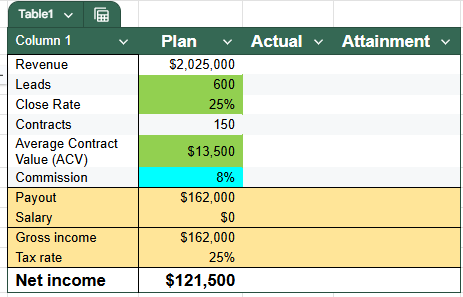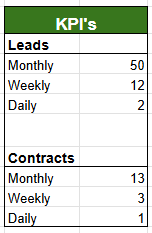Monthly Income Goal Calculator for Commission-Based Roofing Sales: Hit Your Target with Precision

"If you can’t measure it, you can’t improve it." – Peter Drucker.
In commission-based roofing sales, most reps chase goals with a blindfold on. They say they want $10K months or six figures a year — but when you ask how many jobs that means, they freeze.
I saw this first hand during my time in roofing sales and I want make sure you avoid those costly mistakes that so many make.
That’s where a monthly income goal calculator changes the game. It turns dreams into numbers, numbers into actions, and actions into commissions.
This isn’t fluff — it’s a razor-sharp tool to help you know exactly how many deals you need to close each month to stay on track, whether your goal is $8K/month or $250K/year.
What You’ll Learn:
- How to calculate your monthly income target
- The core variables that impact your commissions
- How many roofs you need to close each month
- Free tools and templates to track your progress
Want to know how to create a 6-figure annual income plan? Click here
Why Roofing Sales Reps Need a Monthly Income Calculator
Look, I'll be straight with you – most roofing sales reps I've worked with over the years are flying blind when it comes to their income planning.
They're making gut decisions about how many jobs they need to close, what their average ticket should be, and whether they're on track to hit their goals.
It's honestly painful to watch sometimes.
Here's the thing about commission-based income that took me way too long to figure out: it's gonna fluctuate like crazy, but that doesn't mean you can't plan for it.
I remember my first year in roofing sales, I'd have a killer month pulling in $8K, then the next month I'd barely scrape together $2K.
Talk about stress eating...but welcome so sales.
That's when I started breaking down my annual income goals into monthly targets. Instead of saying "I want to make $100K this year," I figured out I needed roughly $8,333 per month.
Then I worked backwards – if my average commission per job was $400, I needed about 21 closed deals monthly.
The power of knowing your numbers is real. You get confidence because you know exactly what you're working toward, control over your daily activities, and clarity about whether you're ahead or behind.
Trust me, this simple math changed everything about how I approached each day.
Key Inputs for Your Monthly Goal Calculation
Alright, so you're convinced you need to track your numbers – now what?
I learned the hard way that you can't just throw random figures into a calculator and expect magic to happen. You need specific inputs, and honestly, most reps mess this up from the start.
First thing – figure out if you want net or gross monthly income. Sounds simple enough but I made this rookie mistake early on, setting a $7K monthly goal without accounting for taxes and expenses.
Reality check: that $7K gross turned into about $5,200 take-home after Uncle Sam got his cut.
Your average commission per job is huge, but it's not just about the number. Track it over at least 3-6 months because seasonal jobs, insurance claims, and storm work can skew things.
My average ranges from $350 for basic repairs to $800+ for full replacements.
Here's where most people get tripped up – your closing percentage. Don't use what you think it is, use actual data.
I thought I was closing 30% of my leads until I actually tracked it for two months. Turns out it was closer to 22%, which completely changed my lead volume requirements.
And speaking of seasonality – December and January are brutal in most markets, so plan accordingly.
How to Calculate Monthly Goals Step-by-Step
Okay, let's get into the nuts and bolts here. I'm gonna walk you through exactly how I calculate my monthly targets, because honestly, this process saved my bank account more times than I can count.
Step 1: Pick your monthly or annual income target. Let's say you want $10K per month net so that's $120,000 annually. Add about 25% for taxes and expenses – so you're actually aiming for roughly $13.5K gross monthly.
Step 2: Figure out your real average commission per job. Don't guess – pull your last 6 months of data.
Let's say your average contract value is $13,500 and you get a 8% commission which is around $1,080 after factoring in everything from small repairs to big insurance jobs.

Step 3: Simple division time. $13,000 ÷ $1,080 = 13 jobs per month. That's your magic number.
Step 4: Now reverse engineer it. 13 jobs monthly means about 3 jobs per week, or 1-2 jobs every single workday. With a 25% closing rate, you need roughly 50 leads monthly, or about 12 leads weekly, or 2 a day.

Here's some quick examples: For $8K monthly (net), you need about 10 jobs. $15K monthly? You're looking at 19 jobs. $20K monthly means closing 25 jobs – that's serious volume territory.
The beauty is once you know these numbers, every lead matters and every day has purpose.
Monthly Income Goal Calculator Tools (Free & Paid)
So you're ready to build your calculator, but where do you actually put all this together? I've tried pretty much every option out there, and let me save you some trial and error.
I started with a basic spreadsheet template – honestly, it's still what I use everyday. Google Sheets is my go-to because I can access it from my phone during downtime, and it auto-saves everything.
Excel works fine too, but Google Sheets plays nicer with mobile apps and sharing with your team.
If you're already using a CRM like JobNimbus or Roofr, check if they have built-in goal tracking. JobNimbus has this decent dashboard that shows your pipeline value and closing percentages in real-time.
Acculynx is pretty solid too, though their reporting can be a bit clunky.
For daily tracking on the go, I've messed around with apps like Pipedrive and HubSpot's mobile versions. They're okay, but honestly most are overkill for what we need.
Here's the thing about DIY calculators versus automated ones – DIY gives you total control and costs nothing, but you gotta update it manually. Automated tools sync with your CRM data but can get expensive quick, sometimes $50-100+ monthly.
My advice?
Start with a simple Google Sheets template.
Once you're consistently hitting your goals for 3-4 months, then maybe invest in something fancier.
Download our Sales Forecaster Spreadsheet and start predicting your income like a pro.
Tracking Progress Throughout the Month
Here's where most reps mess up – they set their monthly goals, then basically ignore them until the end of the month when they panic.
Been there, done that, got the stress ulcer to prove it.
I learned to do weekly check-ins every Monday morning with my coffee. It's like a mini performance review with myself.
Am I on track? Behind? Ahead?
If I needed 27 jobs this month and it's week 2, I should have at least 13-14 jobs closed or in the pipeline.
Visual tracking is huge for most people. Try using a color-coded system in your spreadsheet – green for closed deals, yellow for pending, red for lost opportunities. Sounds kindergarten-ish, but man, seeing a bunch of red really lights a fire under you.
The key thing that changed everything for me was logging absolutely everything. Every bid, every follow-up call, every "we'll think about it" response, were 1 or 2 decision makers there, how many closed on the first meeting.
I used to only track the wins, which gave me zero insight into what was actually happening in my sales process.
And don't forget to celebrate the small wins along the way.
Hit your weekly target? Buy yourself that fancy coffee.
Closed a big insurance job? Take the afternoon off.
This stuff is hard work, and you deserve to acknowledge when you're crushing it.
Scaling the Calculator for Bigger Goals
So you've been consistently hitting $8K months and now you're eyeing that $15K+ territory. Here's what I wish someone told me earlier – you can't just double your lead volume and expect everything to work the same way.
When I made the jump from $8K to $15K monthly, I had to completely rethink my approach.
You've got a two main levers to pull:
Close more deals - You can do this by either increase the volume of leads which will most likely involve more activity and/or money.
I prefer to go the route of closing more effectively. Same amount of leads, higher conversion.
Make each deal worth more. I focused on both, but deal size was the real game-changer.
Instead of chasing every $300 leak repair, I started targeting full roof replacements, upgrading from builder grade shingles to impact rated shingles, standing seam, or stone-coated steel, especially with insurance jobs.
Imagine your average commission jumping from $400 to about $650 per job. That alone can cut your monthly job requirement from 32 deals down to 23 – way more manageable.
Storm season became my secret weapon. Three good storm months can carry you through slower periods.
Don't sleep on upsells and referrals either. I started offering gutters and solar attic fans. Added maybe $1,8000-2,500 per job on average, which really adds up.
Here's the kicker though – every time you level up, you need a new calculator. Your $8K strategies won't get you to $20K. Trust me on this one.
A roofing sales calculator isn’t just about math — it’s about freedom. When you know your numbers, your income becomes predictable.
And when your income’s predictable, you can plan vacations, investments, and life with confidence.
Which at the end of the day is what we really want.
Start with your ideal monthly number, plug it into the calculator, and break it down into daily actions.
Then work the plan — one roof, one close, one commission at a time.